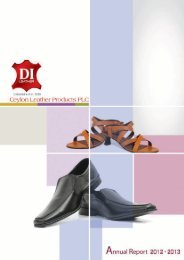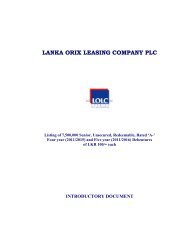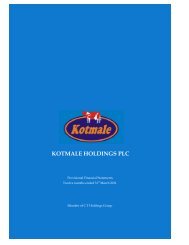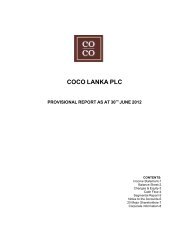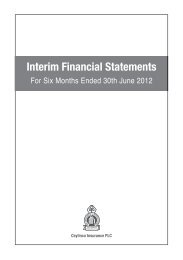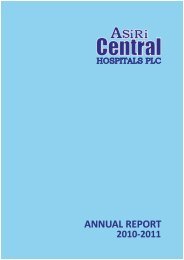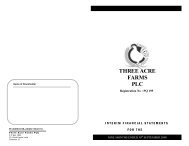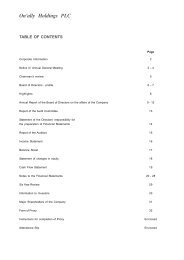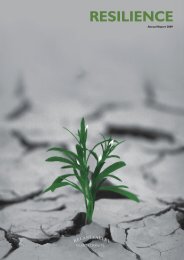Elpitiya Plantations Plc Annual Report 2010/11 - Colombo Stock ...
Elpitiya Plantations Plc Annual Report 2010/11 - Colombo Stock ...
Elpitiya Plantations Plc Annual Report 2010/11 - Colombo Stock ...
Create successful ePaper yourself
Turn your PDF publications into a flip-book with our unique Google optimized e-Paper software.
Notes to the Financial Statements<br />
Year Ended 31 st March 20<strong>11</strong><br />
2.3.3 Borrowing Costs<br />
Borrowing costs are recognised as an expense in the period in which they are incurred, except to the extent where borrowing<br />
costs that are directly attributable to the acquisition, construction, or production of a qualifying asset that takes a substantial<br />
period of time to get ready for its intended use or sale is capitalised as part of that asset. The amount of borrowing costs<br />
eligible for capitalisation is determined in accordance with SLAS 20-Borrowing Costs – Allowed Alternative Treatment. The<br />
capitalisation rate of <strong>11</strong>% (<strong>2010</strong>– 22%) percent was used.<br />
Borrowing costs amounting to Rs. 31,131,878/= (previous year Rs. 97,507,174/=) incurred on borrowings obtained to meet<br />
expenses relating to immature plantations have been capitalised as part of the cost of the immature plantations.<br />
2.3.4 Intangible Assets<br />
Intangible assets acquired separately are measured on initial recognition at cost. The cost of intangible assets acquired in a<br />
business combination is fair value as at the date of acquisition. Following the initial recognition of the intangible assets, the cost<br />
model is applied requiring the assets to be carried at cost less any accumulated amortisation and accumulated impairment<br />
losses. Internally generated intangible assets, excluding capitalised development costs are not capitalised and expenditure is<br />
reflected in the income statement in the year in which the expenditure is incurred.<br />
The useful lives of intangible assets are assessed to be either finite or indefinite.<br />
Intangible assets with finite lives are amortised over the useful economic life and assessed for impairment whenever there is<br />
an indication that the intangible asset may be impaired. The amortisation period and the amortisation method for an intangible<br />
asset with a finite useful life is reviewed at least at each financial year end. Changes in the expected useful life or the expected<br />
pattern of consumption of future economic benefits embodied in the asset is accounted for by changing the amortisation<br />
period or method, as appropriate, and treated as changes in accounting estimates. The amortisation expense on intangible<br />
assets with finite lives is recognised in the income statement in the expense category consistent with the function of the<br />
intangible asset. Amortisation was commenced when the assets were available for use.<br />
As at the balance sheet date, company does not have any intangible assets with finite lives.<br />
Intangible assets with indefinite useful lives are tested for impairment annually either individually or at the cash generating unit<br />
level. Such intangibles are not amortised. The useful life of an intangible asset with an indefinite life is reviewed annually to<br />
determine whether indefinite life assessment continues to be supportable. If not, the change in the useful life assessment from<br />
indefinite to finite is made on a prospective basis.<br />
Intangible assets that are not yet available for sale are tested for impairments at each financial year end, even if there is no<br />
indication that the asset is impaired.<br />
As at the balance sheet date, company does not have any intangible assets with indefinite lives.<br />
Gains or losses arising from derecognition of an intangible asset are measured as the difference between the net disposal<br />
proceeds and the carrying amount of the asset and are recognised in the income statement when the asset is derecognised.<br />
Research and Development Costs<br />
Research costs are expensed as incurred. An intangible assets arising from development expenditure on an individual project<br />
is recognised only when the company can demonstrate the technical feasibility of completing the intangible assets so that it<br />
will be available for use or sale , its intention to complete and its ability to use or sell the assets , how the assets will generate<br />
future economic benefits , the availability of recourses to complete the assets and the ability to measure reliably the expenditure<br />
during the development.<br />
<strong>Elpitiya</strong> <strong>Plantations</strong> <strong>Plc</strong> <strong>Annual</strong> <strong>Report</strong> <strong>2010</strong>/<strong>11</strong><br />
31





